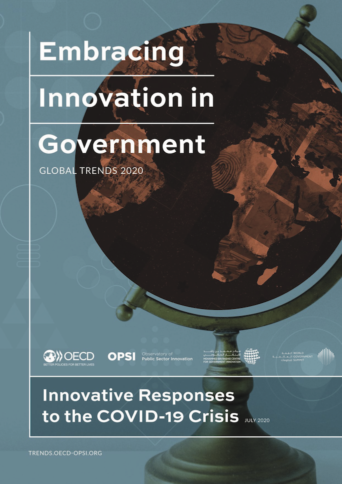Download the Report
Embracing Innovation in Government:
Global Trends 2020
The last few months have made 2020 one of the most challenging years in most of our lifetimes. The novel coronavirus (COVID-19) pandemic has rapidly and drastically changed the daily lives of nearly everyone, with more than half of the world’s population placed in lockdown, the most severe economic recession in nearly a century, healthcare systems pushed to the brink of collapse and, tragically, hundreds of thousands of deaths.
OPSI and the MBRCGI believe that innovation is imperative to success in moving forward. In a chaotic situation with no precedent and no playbook, governments and their partners have few other choices but to act in new ways as they enter uncharted territory. In this context, the sharing of ideas and practices is critical: pandemics do not remain within borders and silos, and neither should the global response.
To facilitate this, OPSI and its colleagues in the OECD Open and Innovative Government (OIG) division have issued a global Call for Innovative Government Responses to COVID-19 in order to gather innovative solutions being piloted by organisations responding to the crisis. Through research and analysis of the over 400 responses submitted be over 60 countries, OPSI and the MBRCGI have identified five key themes that are driving these public sector innovation efforts during the crisis:
Theme 1: Rapid acceleration of digital innovation and transformation.
Compressing years’ worth of technological advancements into a few weeks and months.
Theme 2: Seeking bottom-up solutions and insights.
Building conduits for new ideas, solutions and insights to come from citizens, residents and businesses.
Theme 3: Social solidarity and caring.
The self-activation and mobilisation of millions of individuals who want to help their communities.
Theme 4: Reducing the spread through virus tracking and adaptive action.
Taking actions that are critical to virus tracking and contact tracing in order to “flatten the curve” and limit the spread of the virus.
Theme 5: Forging a path to recovery.
Devising exit strategies and ways to get economies back on track while also re-envisioning what the new normal should be.

Governments around the world have made significant efforts in recent years to shift away from traditional processes and services towards fully digital solutions. Each government has reached a different level of maturity in its digital transformation, however few were technologically prepared to deal with a crisis of the magnitude of COVID-19.
In spite of this, governments have stepped up to take action. Faced with no alternative, they have compressed years’ worth of technological advancements into a few weeks and months. OPSI has found that these efforts are concentrated in three areas: 1) moving towards virtual government operations and services; 2) crafting digitally enabled timely and tailored communication to the public; and 3) enabling these digital innovation and transformation efforts though dedicated teams, guidance, resources and partnerships.

Recognising an opportunity to help sub-national governments cope with the wave of urgent demands provoked by the COVID-19 crisis, and noting willingness among civic-minded technologists to contribute their services, four leaders with significant government and private tech experience created the United States Digital Response (USDR) in March 2020. USDR is a non-partisan, volunteer-driven effort to match experienced pro-bono technologists from across the country with governments responding to COVID-19.
The project rapidly snowballed, attracting more than 5,000 volunteers, and developing a start-up like recruitment pipeline and matchmaking process, contributing to over 150 high-impact projects around the country. When governments need digital help, they can reach out to USDR and receive assistance within one day.

From the start of the COVID-19 crisis, governments have made efforts to pursue all possible paths to identifying innovative, game-changing actions. Recognising that they do not have all the answers, many governments have built conduits to enable citizens and businesses to provide ideas and solutions.
These efforts involve mechanisms that convene individuals at both local and global scales to collaborate over solutions, as well as issue calls to action for start-ups and other businesses to devise and fast-track useful products. Importantly, governments are also seeking bottom-up insights and stories in order to better understand the challenges and needs of their people.

Accelerate Estonia, the Government of Estonia’s project in agile innovation to tackle wicked problems, partnered with the Estonian hackathon-focused non-profit Garage48 to hold Hack the Crisis, a 48-hour hackathon dedicated to building solutions to help the country grapple with the COVID-19 crisis. Over 1 300 civic hackers participated in the event, resulting in 27 teams each working to build out projects, many of which have since been integrated into government operations.
The impact of Hack the Crisis did not end there; the event has been replicated in many other countries. After witnessing the success of the national Hack the Crisis events, the organisers conceived of a global event focusing on broader issues: the Global Hack. They formed partnerships with global organisations and companies to hold a global 48-hour worldwide hackathon on 9-12 April 2020. Together, Hack the Crisis events and the Global Hack have assembled over 200 000 participants who are collectively responsible for developing hundreds of ideas and solutions with potential to make a difference in people’s lives.

It is vital that governments collect and interpret good and timely data about who has the virus, who had the virus, and who those people may have come into contact with and therefore might have the virus. Despite challenges, governments and their partners have been working to develop new and innovative solutions for tracking the virus and identifying people who may have it in order to generate better data and information and ultimately make better decisions for both individual and public health.
Singapore’s Government Technology Agency (GovTech) developed an infrared thermal crowd sensor using store-bought commercially available components augmented with an in-house created facial detection AI system. SPOTON can facilitate quick, effective, crowd temperature screening in busy public spaces and government buildings to help communities ease confinement and prioritise individuals for testing. The price (roughly EUR 750), ease of assembly and the accuracy of the innovative AI technology has generated tremendous interest from governments, who want to use this technology to identify potential COVID-19 cases and allow citizens to return to public spaces.

The enduring nature of the crisis has encouraged governments to start thinking about solutions that will permit the resumption of certain social and economic activities before the virus has been eradicated. Many of these solutions will demand a re-imagining of the previous status quo. Fortunately, crises have historically been strong drivers of innovation. In particular, there is an opportunity not just to imagine how things might be different, but also to start building on these new ideas.
Governments are already taking innovative steps that align closely with the saying “think globally, act locally”, or perhaps more accurately, “think systemically, act locally”. These efforts reflect policy domains that are increasingly indistinct, with policy makers recognising that any innovation exists within complex systems. They also realise the importance of driving recovery efforts at the local level, where government is closest to its people.
Governments and their partners are indeed Forging a Path to Recovery; however, this path is only just beginning to be laid out and will require major efforts over the coming months and years. Fortunately, governments have the potential to shape the way ahead, in large part through innovation.
The COVID-19 crisis is far from over. With no vaccine or treatment widely available, policy makers will continue to walk a tightrope; however, governments and their partners have demonstrated the capacity to manage this delicate balancing act and devise innovative responses under exceptional circumstances.
Going forward, the question is how governments can continue to innovate in individual ways, while simultaneously considering how these innovations fit together as part of a broader picture. While this report is full of examples of innovative action, additional emphasis must be placed on systems strategies for innovation in the medium and long term. Given the urgent short-term demands in times of crisis, it can be difficult to foster a long-term strategic focus. However, as we move towards recovery, efforts to develop a more systems-wide, strategic view of innovation are critical.
Such systems strategies must be both reflective and prospective. In being reflective, governments must consider the ways in which the crisis and governments’ responses can reinforce pre-existing challenges and inequities, such as the digital divide. Furthermore, in rapidly executing solutions, many long-standing difficult debates on privacy and ethics have been fast-tracked. While the public sector has undergone years of advancement in just a few months, governments must not forget to reflect on and seek to address persistent systemic and structural issues. In being prospective, governments must consider what challenges remain on the horizon and what might be done to prepare for these future scenarios. OPSI has found that anticipatory innovation is the least developed of all facets of public sector innovation.
While the crisis has been extremely difficult, it also represents a potential catalyst for change. By moving towards a systems approach, focused on the desired state of the future as well as the lessons and unresolved issues of the past, governments are in a unique position to shape the world in ways unfathomable six months ago.

Social solidarity and caring.
COVID-19 has affected people and businesses in ways that neither they nor governments could prepare for. For months, millions of people globally had to isolate at home, and many continue to do so. In the case of at-risk citizens, such as the elderly or those with pre-existing conditions, leaving the house, even for groceries, could have serious consequences.
Accordingly, communities at all levels began self-activating and organising to develop solutions based on empathy, goodwill and a sense of shared responsibility. These solutions have demonstrated the flexibility, capacity and active participation of civil society organisations and individuals, channelling a spirit of solidarity that has generated thousands of mutual aid initiatives and completely novel structures. These diverse approaches have taken on different sizes and shapes in countries around the world, and governments have gotten involved, seeking to nurture, scale and tap into this positive civic energy.